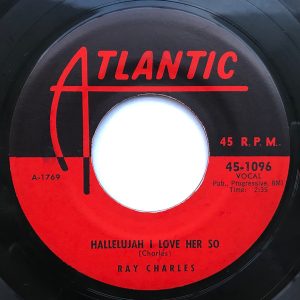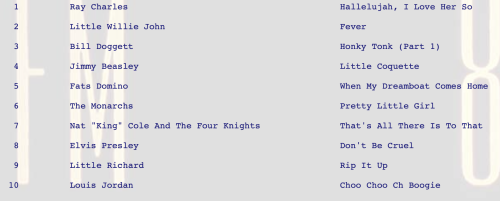#5: Hallelujah I Love Her So by Ray Charles
City: Halifax, NS
Radio Station: CJCH
Peak Month: October 1956
Peak Position in Halifax ~ #1
Peak position in Vancouver ~did not chart
Peak Position on Billboard Hot 100 ~ did not chart
YouTube: “Hallelujah I Love Her So”
Lyrics: “Hallelujah I Love Her So”
Ray Charles Robinson Sr. was born in 1930 in Albany, Georgia. His half-brother, George, was born when Ray was one-years-old. The brother had the same father, but George’s mother was someone the father had taken up with after he abandoned the family in the first year of Ray Charles’ life. George died accidentally in their mother’s laundry tub at the age of 4. From an early age Ray learned to play piano, though he began to lose his sight at the age of 4, and lost it by age 7. In 1937, Ray Charles was sent to St. Augustine (FL) to attend the Florida School for the Deaf and the Blind. At the school, young Ray learned to play classical piano by using braille music. In 1945, his mother died when he was 14-years-old.
Charles began to play piano for bands at the Ritz Theatre an the Afro-American neighborhood in Jacksonville called LaVilla. He made $4 a night (about $68 in 2024 dollars). For some years he lived on the edge of poverty and starvation. In 1949, living in Seattle, Ray Charles was part of the McSon Trio. Their recording of “Confession Blues” reached #2 in some regional R&B markets. Subsequently, he formed the Ray Charles Trio, and in 1951 “Baby Let Me Hold Your Hand” reached the Top 5 on the national R&B charts.
In 1953, Charles switched record labels and signed with Atlantic. He had a #3 R&B hit with “Mess Around”, a #5 hit with “It Should’ve Been Me”, and a Top Ten hit with “Don’t You Know”. But it was his recording in late ’54, “I’ve Got A Woman”, which was a break-out hit that reached #1 on the R&B charts in May 1955. Charles repeated the feat with “A Fool For You”, which peaked at #1 in August 1955. His non-consecutive string of number-one hits continued with “Drown In My Own Tears” in March-April 1956.
Ray Charles twelfth Top Ten hit on the R&B charts in the USA was “Hallelujah I Love Her So”.

Ray Charles wrote “Hallelujah I Love Her So”. In the song, a guy has a girlfriend who “lives next door.” When he needs her and calls her on the phone, she’s at his door by the time he counts to four. Before the sun comes up, “she bring my coffee in my favorite cup.” He knows she has his back. And at after sundown, “she kisses me and holds me tight, and tells me ‘Daddy, everything’s alright’.” Even if he has no friends, this woman’s dependable. At the end of the song, Charles adds, “she’s my little woman, way across town.” Perhaps he was just riffing off of his earlier number-one hit from 1955, “I’ve Got A Woman”, where the gal he’s in love with lives “way across town.” But in “Hallelujah I Love Her So”, the lady lives “next door.” (Perhaps she has two places of residence?) I don’t think we’re meant to take the added line, that trails off at the end of the record, as trumping the storyline from the outset, that “she’s my baby and she lives next door.”
“Hallelujah I Love Her So” peaked at #1 in Halifax (NS), #2 in Nashville, #3 in Philadelphia, #5 in Dallas, #6 in Lawrence (MA), and #7 in Pittsburgh.
In 1957, a jazz album titled The Great Ray Charles was released. His single, “Ain’t That Love” reached #3 on CKEY in Toronto in early ’57. As well, his debut album – Ray Charles – consisted of 14 tracks, eleven of which had been Top Ten hits between 1953 and 1957. In December 1957, “Swanee River Rock” reached #6 in Dauphin (MB). In 1958, Ray Charles appeared at the Newport Jazz Festival and recorded his first live album from his performance. He also performed at Carnegie Hall, and at the Shrine Auditorium in Los Angeles. The latter as one of the headliners alongside Sam Cooke, Little Willie John, and Ernie Freeman.
Charles was back in the Top Ten on the R&B charts in 1959 with “Night Time Is The Right Time”. But it was “What’d I Say” that became his first crossover hit to crack the Top 50 on the Billboard Hot 100. It reached #1 on the Hot R&B Sides chart and #6 on the Hot 100. In Canada, “What’d I Say” cracked the Top Ten in Calgary (#6) and Cornwall, Ontario (#7). From this point on, most of his single releases were crossover R&B to pop hits.
In November 1959, Charles signed with ABC-Paramount and had his first number-one hit on the Billboard Hot 100 with “Georgia On My Mind”. The single peaked at #3 on the Hot R&B Sides chart and #24 in the UK. “Georgia On My Mind” won Grammy Awards for Best Performance by a Pop Single Artist, and Best Vocal Performance Single Record or Track, Male Vocalist, and got a nomination for Record of the Year. While The Genius of Ray Charles won him a Grammy Award for Best Vocal Performance Album, Male. As well, Charles also won a Grammy for “Let The Good Times Roll” in the Best Rhythm & Blues Performance category.
In 1961, Ray Charles had a #1 R&B hit with “One Mint Julep”, and a #1 hit on both the pop and R&B charts with “Hit The Road Jack”. In Canada, it was only in Vancouver where the song topped that pop charts. “Hit The Road Jack” won Charles a Grammy Award for Best Rhythm & Blues Recording. A third Top Ten pop hit and third #1 R&B hit in ’61 for Ray Charles was “Unchain My Heart”. While in 1960, The Genius Hits the Road became his first Top Ten studio album on the Billboard Top LPs chart. While Genius + Soul = Jazz reached #4 on the Top LPs chart in 1961. The latter received a Grammy Award nomination for Album of the Year.
During this time his albums, Modern Sounds in Country and Western Music, Modern Sounds in Country and Western Music Volume Two, and Ingredients in a Recipe for Soul were released. These albums were big sellers on the album charts. The first of these topped the Billboard Top LPs chart, and reached #6 in the UK. It also earned a Grammy Award nomination for Album of the Year. The second reached #2 in the USA and #15 in the UK. While Ingredients in a Recipe for Soul peaked at #2 on the Top LPs chart
His chart-topping ways continued in 1962 with “I Can’t Stop Loving You”. The single reached number-one in Australia, Sweden, the UK and USA, and #4 in Norway. Though Canada didn’t have a national pop chart at the time, “I Can’t Stop Loving You” peaked at #1 in Montreal, Ottawa, and Toronto. (It stalled in Vancouver at #41). At the Grammy Awards, Ray Charles received three nominations for “I Can’t Stop Loving You”, winning in the Best Rhythm & Blues Recording category.
Ray Charles also had Top Ten hits in ’62 with “You Are My Sunshine” and “You Don’t Know Me”. While in 1963, he was back in the Top Ten with “Take These Chains From My Heart” and “Busted”. The latter got two Grammy nominations, and Charles won in the Best Rhythm & Blues Recording category.
During the British Invasion, Ray Charles struggled to find commercial success. He had a couple of Top Ten hits on the Hot R&B Sides chart in ’64, but waited until 1966 when “Crying Time” cracked the Top Ten. For his effort, he won a Grammy Awards for Best R&B Solo Performance, and for Best R&B Recording. And though “Let’s Go Get Stoned” stalled at #50 on the Billboard Hot 100, it climbed to #1 on the R&B charts in ’66.
In 1967, “Here We Go Again” reached #15 on the Hot 100, and #5 on the R&B charts. He would release over two dozen more singles into the 70s. But few of these cracked the Top 40, with his cover of the Beatles’ “Yesterday” reaching #25 in 1967. For this recording, Ray Charles received three Grammy Award nominations.
In April 1979, “Georgia On My Mind” became the official song for the state of Georgia. He performed the song before the state lawmakers in March ’79.
In the 1980s, on the Columbia label, Ray Charles had several Top Ten hits on the Country & Western charts. “Seven Spanish Angels” peaked at #1 in 1985 in a duet with Willie Nelson. In 1990, with Quincy Jones and Chaka Khan, a cover of the Brothers Johnson’s “I’ll Be Good to You” peaked at #1 on the Hot Black Singles and Hot Dance Club Play charts. The single earned the trio a Grammy Award in the Best R&B Performance by a Duo or Group with Vocal.
Over the years, Ray Charles received 37 Grammy nominations and won 17 awards.
In 2004, Ray Charles died at the age of 73 due to liver failure. At the 47th Grammy Awards in February 2005, Ray Charles there was a Tribute to Ray Charles. The winner for Record of the Year and also Best Pop Collaboration with Vocals were Ray Charles & Norah Jones for their duet “Here We Go Again”. Charles also posthumously won Album of the Year and Best Pop Vocal Album for Genius Loves Company. On the album, Ray Charles sang duets with a variety of recording stars. These included Gladys Knight, Johnny Mathis, Elton John, James Taylor, Van Morrison, B.B. King, Diana Krall, Nathalie Cole, Michael MacDonald, and Bonnie Raitt. Genius Loves Company topped the pop album charts in Austria, Canada, Italy and the USA.
April 19, 2024
Ray McGinnis
References:
Jon Pareles and Bernard Weinraub, “Ray Charles: Bluesy Essence of Soul, is Dead at 73,” New York Times, June 11, 2004.
Gail Mitchell, “Ray Charles innovated in business as well as music,” Reuters, September 17, 2010.
Van Morrison, “Ray Charles: #10 – 100 Greatest Artists,” Rolling Stone, April 20, 2011.
“Ray Charles Chart History,” Billboard (pop charts), February 1990.
Rebecca Burns, “32 Years Ago This Month: Ray Charles Serenades the Legislature,” Atlanta magazine, March 7, 1979.

CJCH 920-AM Halifax (NS) Top Ten | October 6, 1956

“Hallelujah I Love Her So” is one of Ray’s best. I also like the cover version that Eddie Cochran did in 1959 even though it did not chart.